Tianyu Zheng
COIG-P: A High-Quality and Large-Scale Chinese Preference Dataset for Alignment with Human Values
Apr 07, 2025Abstract:Aligning large language models (LLMs) with human preferences has achieved remarkable success. However, existing Chinese preference datasets are limited by small scale, narrow domain coverage, and lack of rigorous data validation. Additionally, the reliance on human annotators for instruction and response labeling significantly constrains the scalability of human preference datasets. To address these challenges, we design an LLM-based Chinese preference dataset annotation pipeline with no human intervention. Specifically, we crawled and carefully filtered 92k high-quality Chinese queries and employed 15 mainstream LLMs to generate and score chosen-rejected response pairs. Based on it, we introduce COIG-P (Chinese Open Instruction Generalist - Preference), a high-quality, large-scale Chinese preference dataset, comprises 1,009k Chinese preference pairs spanning 6 diverse domains: Chat, Code, Math, Logic, Novel, and Role. Building upon COIG-P, to reduce the overhead of using LLMs for scoring, we trained a 8B-sized Chinese Reward Model (CRM) and meticulously constructed a Chinese Reward Benchmark (CRBench). Evaluation results based on AlignBench \citep{liu2024alignbenchbenchmarkingchinesealignment} show that that COIG-P significantly outperforms other Chinese preference datasets, and it brings significant performance improvements ranging from 2% to 12% for the Qwen2/2.5 and Infinity-Instruct-3M-0625 model series, respectively. The results on CRBench demonstrate that our CRM has a strong and robust scoring ability. We apply it to filter chosen-rejected response pairs in a test split of COIG-P, and our experiments show that it is comparable to GPT-4o in identifying low-quality samples while maintaining efficiency and cost-effectiveness. Our codes and data are released in https://github.com/multimodal-art-projection/COIG-P.
YuE: Scaling Open Foundation Models for Long-Form Music Generation
Mar 11, 2025Abstract:We tackle the task of long-form music generation--particularly the challenging \textbf{lyrics-to-song} problem--by introducing YuE, a family of open foundation models based on the LLaMA2 architecture. Specifically, YuE scales to trillions of tokens and generates up to five minutes of music while maintaining lyrical alignment, coherent musical structure, and engaging vocal melodies with appropriate accompaniment. It achieves this through (1) track-decoupled next-token prediction to overcome dense mixture signals, (2) structural progressive conditioning for long-context lyrical alignment, and (3) a multitask, multiphase pre-training recipe to converge and generalize. In addition, we redesign the in-context learning technique for music generation, enabling versatile style transfer (e.g., converting Japanese city pop into an English rap while preserving the original accompaniment) and bidirectional generation. Through extensive evaluation, we demonstrate that YuE matches or even surpasses some of the proprietary systems in musicality and vocal agility. In addition, fine-tuning YuE enables additional controls and enhanced support for tail languages. Furthermore, beyond generation, we show that YuE's learned representations can perform well on music understanding tasks, where the results of YuE match or exceed state-of-the-art methods on the MARBLE benchmark. Keywords: lyrics2song, song generation, long-form, foundation model, music generation
SuperGPQA: Scaling LLM Evaluation across 285 Graduate Disciplines
Feb 20, 2025Abstract:Large language models (LLMs) have demonstrated remarkable proficiency in mainstream academic disciplines such as mathematics, physics, and computer science. However, human knowledge encompasses over 200 specialized disciplines, far exceeding the scope of existing benchmarks. The capabilities of LLMs in many of these specialized fields-particularly in light industry, agriculture, and service-oriented disciplines-remain inadequately evaluated. To address this gap, we present SuperGPQA, a comprehensive benchmark that evaluates graduate-level knowledge and reasoning capabilities across 285 disciplines. Our benchmark employs a novel Human-LLM collaborative filtering mechanism to eliminate trivial or ambiguous questions through iterative refinement based on both LLM responses and expert feedback. Our experimental results reveal significant room for improvement in the performance of current state-of-the-art LLMs across diverse knowledge domains (e.g., the reasoning-focused model DeepSeek-R1 achieved the highest accuracy of 61.82% on SuperGPQA), highlighting the considerable gap between current model capabilities and artificial general intelligence. Additionally, we present comprehensive insights from our management of a large-scale annotation process, involving over 80 expert annotators and an interactive Human-LLM collaborative system, offering valuable methodological guidance for future research initiatives of comparable scope.
Steel-LLM:From Scratch to Open Source -- A Personal Journey in Building a Chinese-Centric LLM
Feb 10, 2025Abstract:Steel-LLM is a Chinese-centric language model developed from scratch with the goal of creating a high-quality, open-source model despite limited computational resources. Launched in March 2024, the project aimed to train a 1-billion-parameter model on a large-scale dataset, prioritizing transparency and the sharing of practical insights to assist others in the community. The training process primarily focused on Chinese data, with a small proportion of English data included, addressing gaps in existing open-source LLMs by providing a more detailed and practical account of the model-building journey. Steel-LLM has demonstrated competitive performance on benchmarks such as CEVAL and CMMLU, outperforming early models from larger institutions. This paper provides a comprehensive summary of the project's key contributions, including data collection, model design, training methodologies, and the challenges encountered along the way, offering a valuable resource for researchers and practitioners looking to develop their own LLMs. The model checkpoints and training script are available at https://github.com/zhanshijinwat/Steel-LLM.
Aligning Instruction Tuning with Pre-training
Jan 16, 2025



Abstract:Instruction tuning enhances large language models (LLMs) to follow human instructions across diverse tasks, relying on high-quality datasets to guide behavior. However, these datasets, whether manually curated or synthetically generated, are often narrowly focused and misaligned with the broad distributions captured during pre-training, limiting LLM generalization and effective use of pre-trained knowledge. We propose *Aligning Instruction Tuning with Pre-training* (AITP), a method that bridges this gap by identifying coverage shortfalls in instruction-tuning datasets and rewriting underrepresented pre-training data into high-quality instruction-response pairs. This approach enriches dataset diversity while preserving task-specific objectives. Evaluations on three fully open LLMs across eight benchmarks demonstrate consistent performance improvements with AITP. Ablations highlight the benefits of adaptive data selection, controlled rewriting, and balanced integration, emphasizing the importance of aligning instruction tuning with pre-training distributions to unlock the full potential of LLMs.
KARPA: A Training-free Method of Adapting Knowledge Graph as References for Large Language Model's Reasoning Path Aggregation
Dec 30, 2024Abstract:Large language models (LLMs) demonstrate exceptional performance across a variety of tasks, yet they are often affected by hallucinations and the timeliness of knowledge. Leveraging knowledge graphs (KGs) as external knowledge sources has emerged as a viable solution, but existing methods for LLM-based knowledge graph question answering (KGQA) are often limited by step-by-step decision-making on KGs, restricting the global planning and reasoning capabilities of LLMs, or they require fine-tuning or pre-training on specific KGs. To address these challenges, we propose Knowledge graph Assisted Reasoning Path Aggregation (KARPA), a novel framework that harnesses the global planning abilities of LLMs for efficient and accurate KG reasoning. KARPA operates in three steps: pre-planning relation paths using the LLM's global planning capabilities, matching semantically relevant paths via an embedding model, and reasoning over these paths to generate answers. Unlike existing KGQA methods, KARPA avoids stepwise traversal, requires no additional training, and is adaptable to various LLM architectures. Extensive experimental results show that KARPA achieves state-of-the-art performance in KGQA tasks, delivering both high efficiency and accuracy. Our code will be available on Github.
SimulBench: Evaluating Language Models with Creative Simulation Tasks
Sep 11, 2024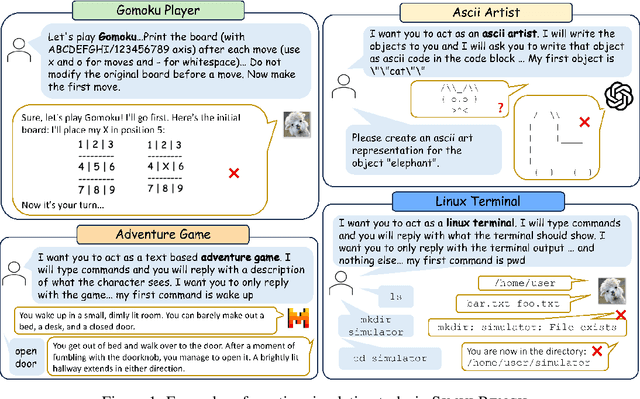

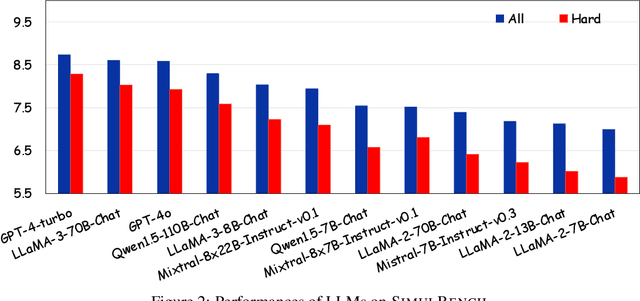
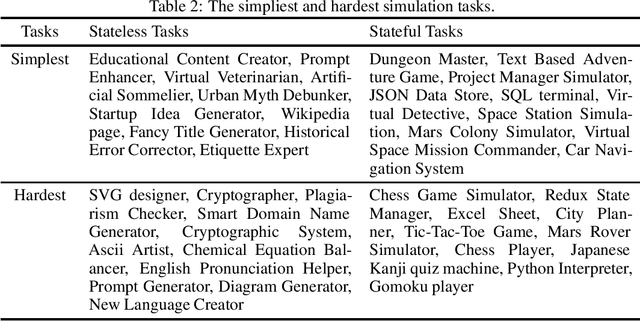
Abstract:We introduce SimulBench, a benchmark designed to evaluate large language models (LLMs) across a diverse collection of creative simulation scenarios, such as acting as a Linux terminal or playing text games with users. While these simulation tasks serve as effective measures of an LLM's general intelligence, they are seldom incorporated into existing benchmarks. A major challenge is to develop an evaluation framework for testing different LLMs fairly while preserving the multi-round interactive nature of simulation tasks between users and AI. To tackle this issue, we suggest using a fixed LLM as a user agent to engage with an LLM to collect dialogues first under different tasks. Then, challenging dialogue scripts are extracted for evaluating different target LLMs. To facilitate automatic assessment on \DataName{}, GPT-4 is employed as the evaluator, tasked with reviewing the quality of the final response generated by the target LLMs given multi-turn dialogue scripts. Our comprehensive experiments indicate that these simulation tasks continue to pose a significant challenge with their unique natures and show the gap between proprietary models and the most advanced open LLMs. For example, GPT-4-turbo outperforms LLaMA-3-70b-Chat on 18.55\% more cases.
LIME-M: Less Is More for Evaluation of MLLMs
Sep 10, 2024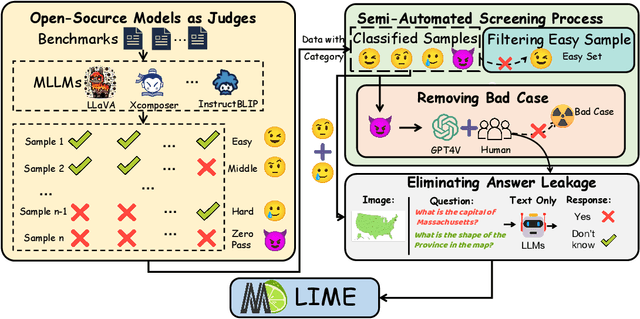
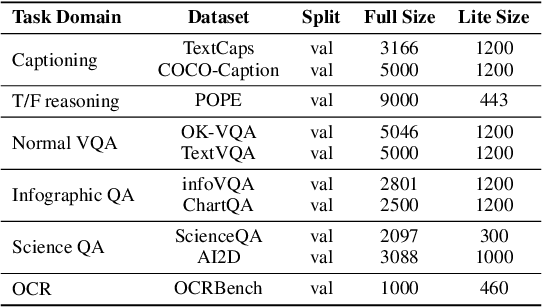
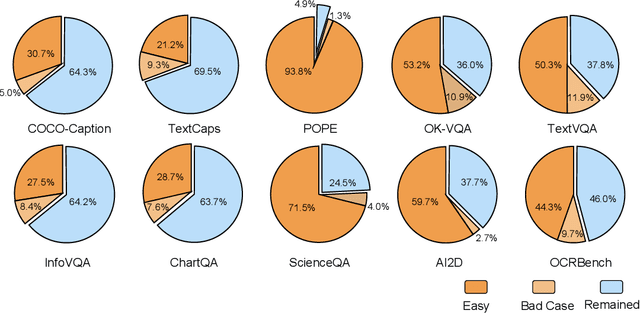
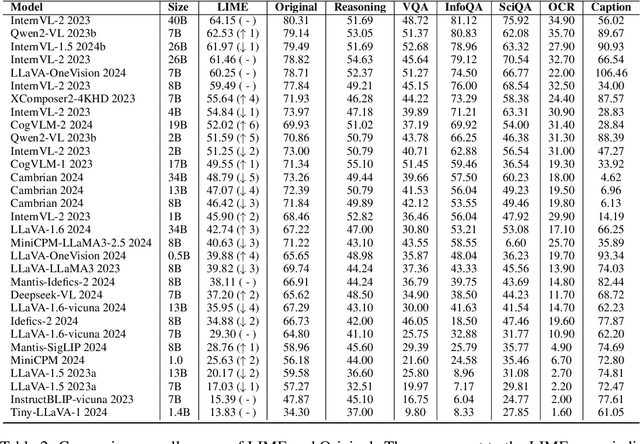
Abstract:With the remarkable success achieved by Multimodal Large Language Models (MLLMs), numerous benchmarks have been designed to assess MLLMs' ability to guide their development in image perception tasks (e.g., image captioning and visual question answering). However, the existence of numerous benchmarks results in a substantial computational burden when evaluating model performance across all of them. Moreover, these benchmarks contain many overly simple problems or challenging samples, which do not effectively differentiate the capabilities among various MLLMs. To address these challenges, we propose a pipeline to process the existing benchmarks, which consists of two modules: (1) Semi-Automated Screening Process and (2) Eliminating Answer Leakage. The Semi-Automated Screening Process filters out samples that cannot distinguish the model's capabilities by synthesizing various MLLMs and manually evaluating them. The Eliminate Answer Leakage module filters samples whose answers can be inferred without images. Finally, we curate the LIME-M: Less Is More for Evaluation of Multimodal LLMs, a lightweight Multimodal benchmark that can more effectively evaluate the performance of different models. Our experiments demonstrate that: LIME-M can better distinguish the performance of different MLLMs with fewer samples (24% of the original) and reduced time (23% of the original); LIME-M eliminates answer leakage, focusing mainly on the information within images; The current automatic metric (i.e., CIDEr) is insufficient for evaluating MLLMs' capabilities in captioning. Moreover, removing the caption task score when calculating the overall score provides a more accurate reflection of model performance differences. All our codes and data are released at https://github.com/kangreen0210/LIME-M.
MMMU-Pro: A More Robust Multi-discipline Multimodal Understanding Benchmark
Sep 04, 2024



Abstract:This paper introduces MMMU-Pro, a robust version of the Massive Multi-discipline Multimodal Understanding and Reasoning (MMMU) benchmark. MMMU-Pro rigorously assesses multimodal models' true understanding and reasoning capabilities through a three-step process based on MMMU: (1) filtering out questions answerable by text-only models, (2) augmenting candidate options, and (3) introducing a vision-only input setting where questions are embedded within images. This setting challenges AI to truly "see" and "read" simultaneously, testing a fundamental human cognitive skill of seamlessly integrating visual and textual information. Results show that model performance is substantially lower on MMMU-Pro than on MMMU, ranging from 16.8% to 26.9% across models. We explore the impact of OCR prompts and Chain of Thought (CoT) reasoning, finding that OCR prompts have minimal effect while CoT generally improves performance. MMMU-Pro provides a more rigorous evaluation tool, closely mimicking real-world scenarios and offering valuable directions for future research in multimodal AI.
Research Advances and New Paradigms for Biology-inspired Spiking Neural Networks
Aug 26, 2024Abstract:Spiking neural networks (SNNs) are gaining popularity in the computational simulation and artificial intelligence fields owing to their biological plausibility and computational efficiency. This paper explores the historical development of SNN and concludes that these two fields are intersecting and merging rapidly. Following the successful application of Dynamic Vision Sensors (DVS) and Dynamic Audio Sensors (DAS), SNNs have found some proper paradigms, such as continuous visual signal tracking, automatic speech recognition, and reinforcement learning for continuous control, that have extensively supported their key features, including spike encoding, neuronal heterogeneity, specific functional circuits, and multiscale plasticity. Compared to these real-world paradigms, the brain contains a spiking version of the biology-world paradigm, which exhibits a similar level of complexity and is usually considered a mirror of the real world. Considering the projected rapid development of invasive and parallel Brain-Computer Interface (BCI), as well as the new BCI-based paradigms that include online pattern recognition and stimulus control of biological spike trains, SNNs naturally leverage their advantages in energy efficiency, robustness, and flexibility. The biological brain has inspired the present study of SNNs and effective SNN machine-learning algorithms, which can help enhance neuroscience discoveries in the brain by applying them to the new BCI paradigm. Such two-way interactions with positive feedback can accelerate brain science research and brain-inspired intelligence technology.
 Add to Chrome
Add to Chrome Add to Firefox
Add to Firefox Add to Edge
Add to Edge